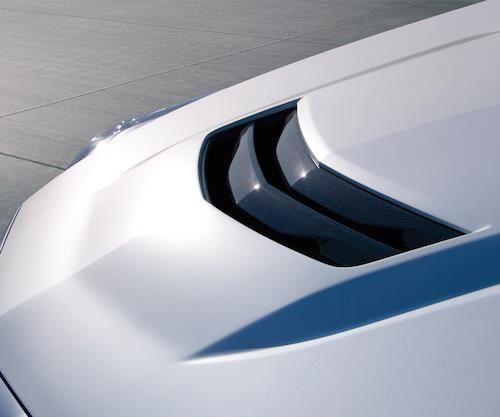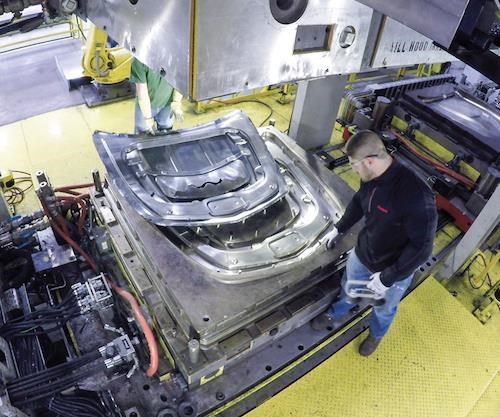Carbon/epoxy Cadillac hood
Automated process for prepreg hood inner/outer cuts weight by 20% and yields Class A exterior out of the autoclave.
Although they typically keep their research efforts close to the vest, automakers and automotive Tier suppliers nevertheless are always in the process of evaluating the multitude of materials available for lightweighting, in their efforts to meet fuel economy mandates. One example is automotive Tier 1 giant Magna International Inc. (Aurora, ON, Canada), a leading automotive supplier with more than 140,000 employees in 29 countries. The company started a carbon fiber composites program in 2008, says Tom Pilette, its global VP, product and process development. “We began developing composites for structural parts, as well as Class A body panels,” he recalls. At that time, Magna made a joint development agreement with commercial-grade carbon fiber manufacturer Zoltek Corp. (Bridgeton, MO, US), using that company’s 50K carbon tow materials in its part development efforts. “We saw the lightweighting trend coming,” he points out, “but knew it was going to be a long process.”
Quote on a Caddy
That early work led to an opportunity in 2013 to submit a quote to General Motors (Detroit, MI, US) for composite hoods on the 2016 model year Cadillac ATS/CTS V-Series cars, two higher-performance Cadillac models. Approximately 7,000 parts are being produced each year for each model, for a total of 14,000 hoods, but the capacity exists for much greater volumes. The hood was a winner of a JEC Innovation Award in the Automotive category, at the JEC Americas 2016 event in Atlanta, GA, US.
Andrew Swikoski, global product line director for lightweight composites, explains that the Cadillac hood was a good candidate part for lightweighting, given its location above the car’s center of gravity and forward of the axle. The carbon fiber/epoxy composite provides the stiffness needed to avoid hood “flutter” and has resulted in a mass savings of 20-30% compared to aluminum or steel hoods (the range depends on the grade of steel or aluminum to which it is compared).
The hood is produced in an out-of-autoclave compression molding process that takes just minutes per part, yet produces a Class A exterior surface. A key achievement of the hood program, Pilette adds, is that the parts can be post-processed just like metallic versions; that is, the carbon fiber/epoxy material can withstand Magna’s conventional metal-part painting process and its associated bake temperatures — there was no need to resort to offline manual painting and “finesse and filler” steps. “Our goal was to have a composite part capable of seamless, inline finish processing,” Pilette points out.
Iterative progress toward success
The hood was designed with a unidirectional carbon fiber inner and outer, with an optional exposed carbon fiber inner, adhesively bonded together. Steel hard points are bonded at hinge and latch attachment locations. The outer panel has a thickness of 1.2 mm, and the inner, 0.8 mm. Working closely with material suppliers Zoltek and Barrday Composite Solutions (Millbury, MA, US) at the Magna-NRC Composites Centre of Excellence — a joint Magna/Canadian research center dedicated to composites located at Magna’s Concord, ON, Canada facility — Magna went through “many iterations” of resin chemistry development, prepreg stack design, tool design and cycle time tweaks to achieve an acceptable finished outer surface, says Pilette. The resulting prepreg resin system, supplied by Barrday, is a customized, toughened epoxy. Combined with Zoltek fiber, it makes a prepreg with a high glass transition temperature (Tg) that can handle the Magna paint line’s temperatures.
“Typically, a prepreg part charge tends to be a patchwork of multiple plies that takes time to lay up manually,” explains Pilette.
The Magna team has perfected an automated workcell that creates a molding charge by robotically laying multiple plies of standard-width, 0.02 mm-thick, Barrday prepreg in a 0°/90° orientation, which are CNC cut into a charge pattern that is robotically transferred to the mold. The patented mold tools (upper and lower) feature a shear-edge steel design, with a “unique” and proprietary combination of tooling features that reportedly manage the movement of the stacked plies during mold close and pressure application. Adds Pilette, “The prepreg starts to cure as soon as it hits the heated tool, so the stack has to be placed precisely and stay in place. The tool helps maintain resin consistency, ensures good fiber wetout and part thickness.” He notes that Fibersim software from Siemens PLM Software Inc. (Plano, TX, US) was a manufacturability tool that “helped tremendously” in developing the prepreg stack pattern for compression molding.
The Barrday material is manufactured in that company’s Cambridge, ON, Canada, facility, and molding occurs at Magna subsidiary Polycon Industries (Guelph, ON, Canada). The process begins with automated layup and ply stacking, charge cutting and mold loading. After mold close and press application, cure takes about 10 minutes. A robot removes the molded part, shuttles it to a router cell for trimming, then to a fixture in a bonding cell. Bonding of the inner and outer panels also is automated, and the metallic hinge and closure elements, while positioned by hand, are also robotically bonded, using Pliogrip two-part urethane adhesive from Ashland Performance Materials (Columbus, OH, US). Bonded parts then go to the Magna paint line and, after painting, are shipped to General Motors. “We’re now working on cutting that cure time in half, with adjustments to the epoxy,” asserts Pilette.
Other panels, more platforms
Now that a robust and successful molding process has been developed, Pilette and Swikoski both say that Magna’s goal is to expand the use of this newly developed technology with multiple carbon composite body panels, and to do so on more platforms. “We understand these materials, and with our in-house chemists and laboratory, and collaboration with our supply partners, we can offer solutions to meet our customers’ needs,” Pilette contends.
Related Content
SMC composites progress BinC solar electric vehicles
In an interview with one of Aptera’s co-founders, CW sheds light on the inspiration behind the crowd-funded solar electric vehicle, its body in carbon (BinC) and how composite materials are playing a role in its design.
Read MoreCo-molding SMC with braided glass fiber demonstrates truck bed potential
Prepreg co-molding compound by IDI Composites International and A&P Technology enables new geometries and levels of strength and resiliency for automotive, mobility.
Read MoreASCEND program update: Designing next-gen, high-rate auto and aerospace composites
GKN Aerospace, McLaren Automotive and U.K.-based partners share goals and progress aiming at high-rate, Industry 4.0-enabled, sustainable materials and processes.
Read MoreMcLaren celebrates 10 years of the McLaren P1 hybrid hypercar
Lightweight carbon fiber construction, Formula 1-inspired aerodynamics and high-performance hybrid powertrain technologies hallmark this hybrid vehicle, serve as a springboard for new race cars.
Read MoreRead Next
Developing bonded composite repair for ships, offshore units
Bureau Veritas and industry partners issue guidelines and pave the way for certification via StrengthBond Offshore project.
Read MoreVIDEO: High-volume processing for fiberglass components
Cannon Ergos, a company specializing in high-ton presses and equipment for composites fabrication and plastics processing, displayed automotive and industrial components at CAMX 2024.
Read MorePlant tour: Daher Shap’in TechCenter and composites production plant, Saint-Aignan-de-Grandlieu, France
Co-located R&D and production advance OOA thermosets, thermoplastics, welding, recycling and digital technologies for faster processing and certification of lighter, more sustainable composites.
Read More















.jpg;maxWidth=300;quality=90)












